Using flipped classroom model in teaching karl Marx - F. Engels – V.I. Lenin’s classical works for students majoring in political education
Teaching class works for students majoring in political education plays a crucial
role in training curriculum. This research paper discusses using flipped classroom model to
replace the traditional one in teaching the above mentioned subject in order to form students’
essential personalities and competencies to meet the need of education innovation cause.
With such research methods as observing, analyzing, synthesizing and consulting materials,
the piece of writing shows features of teaching classical works, at the same time clarifies
advantages of flipped classroom model when teaching these contents. After that, the research
reveals procedure, requirements of using flipped classroom model to teach classical works
for the highest effectiveness.
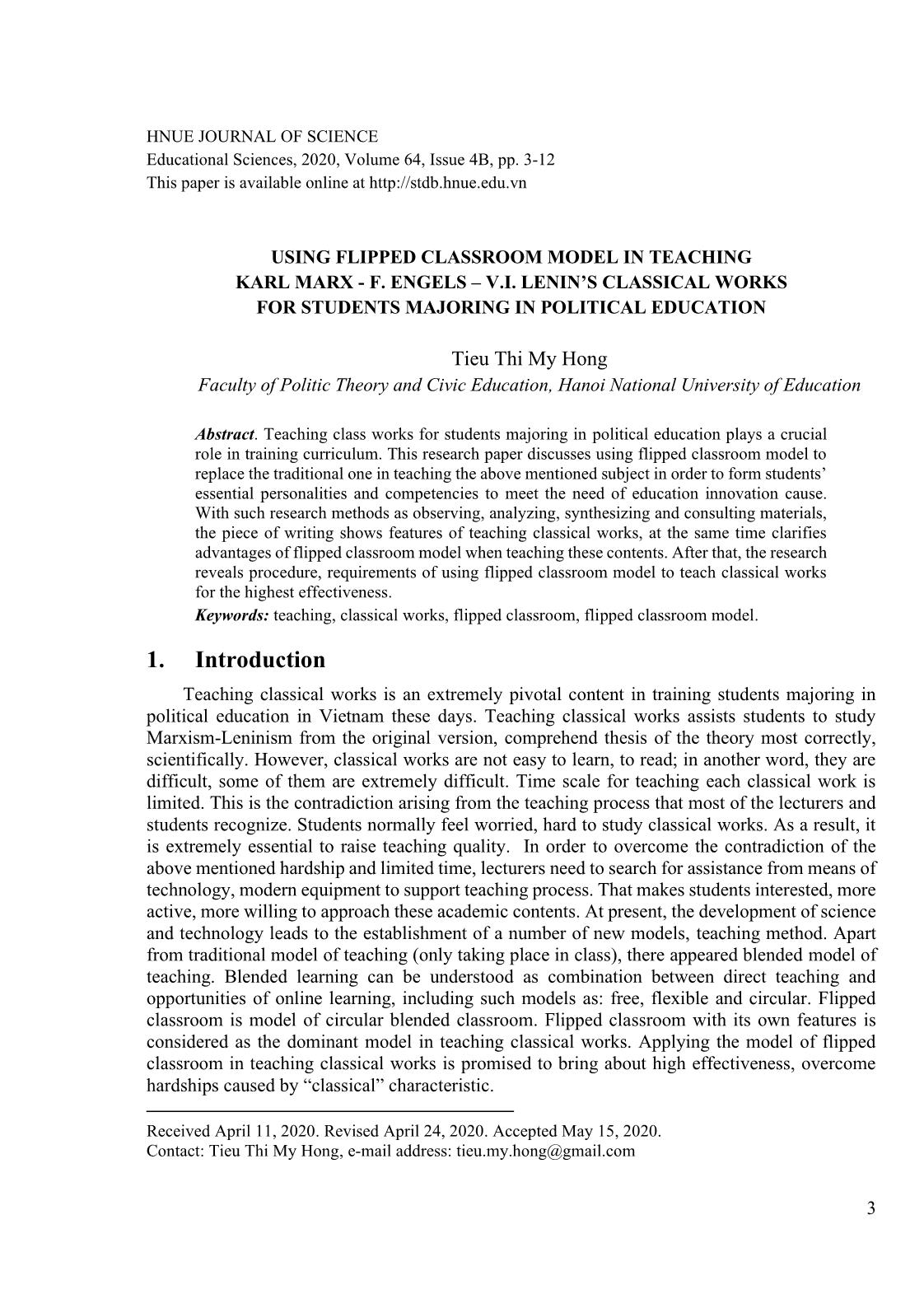
Trang 1
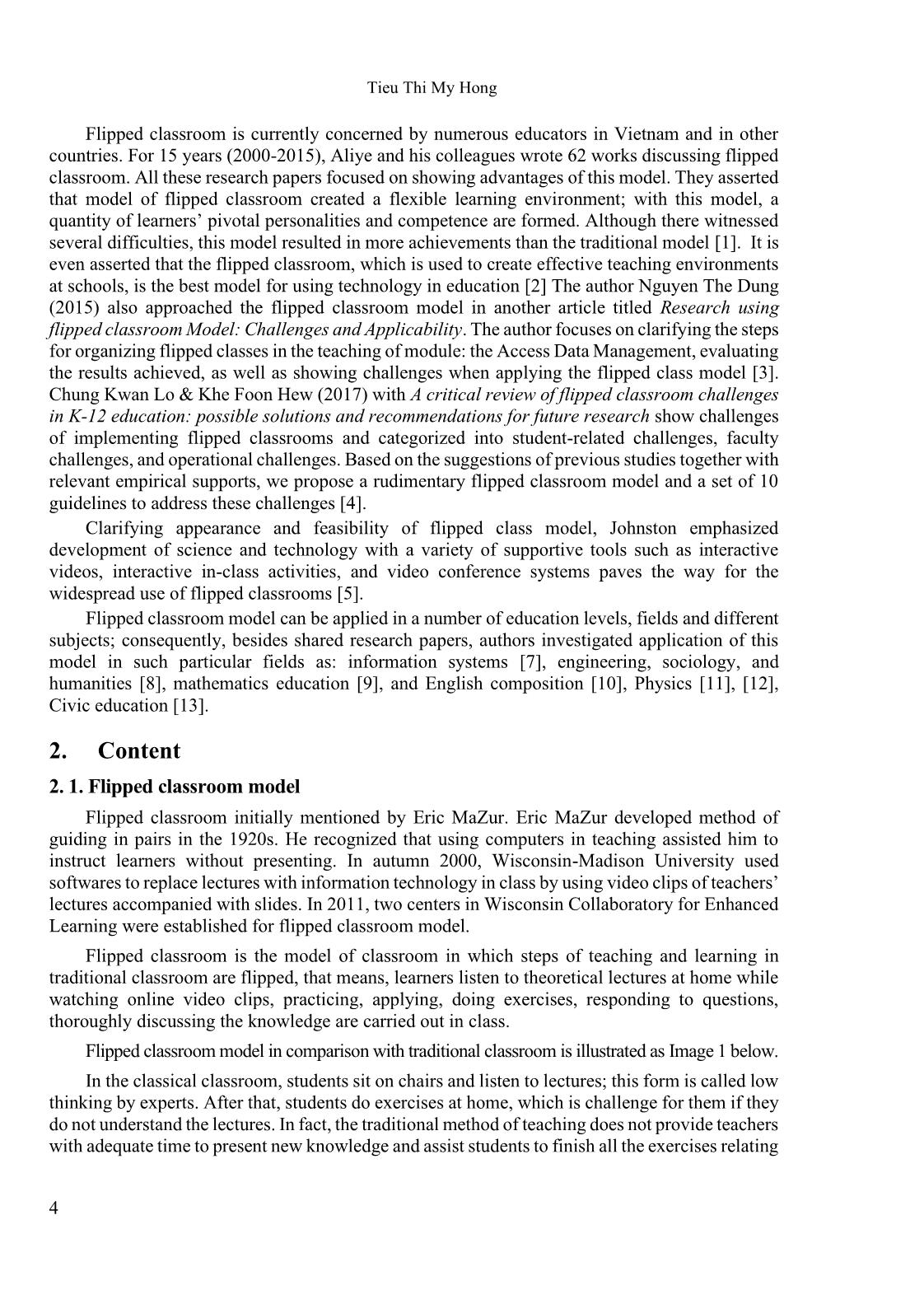
Trang 2
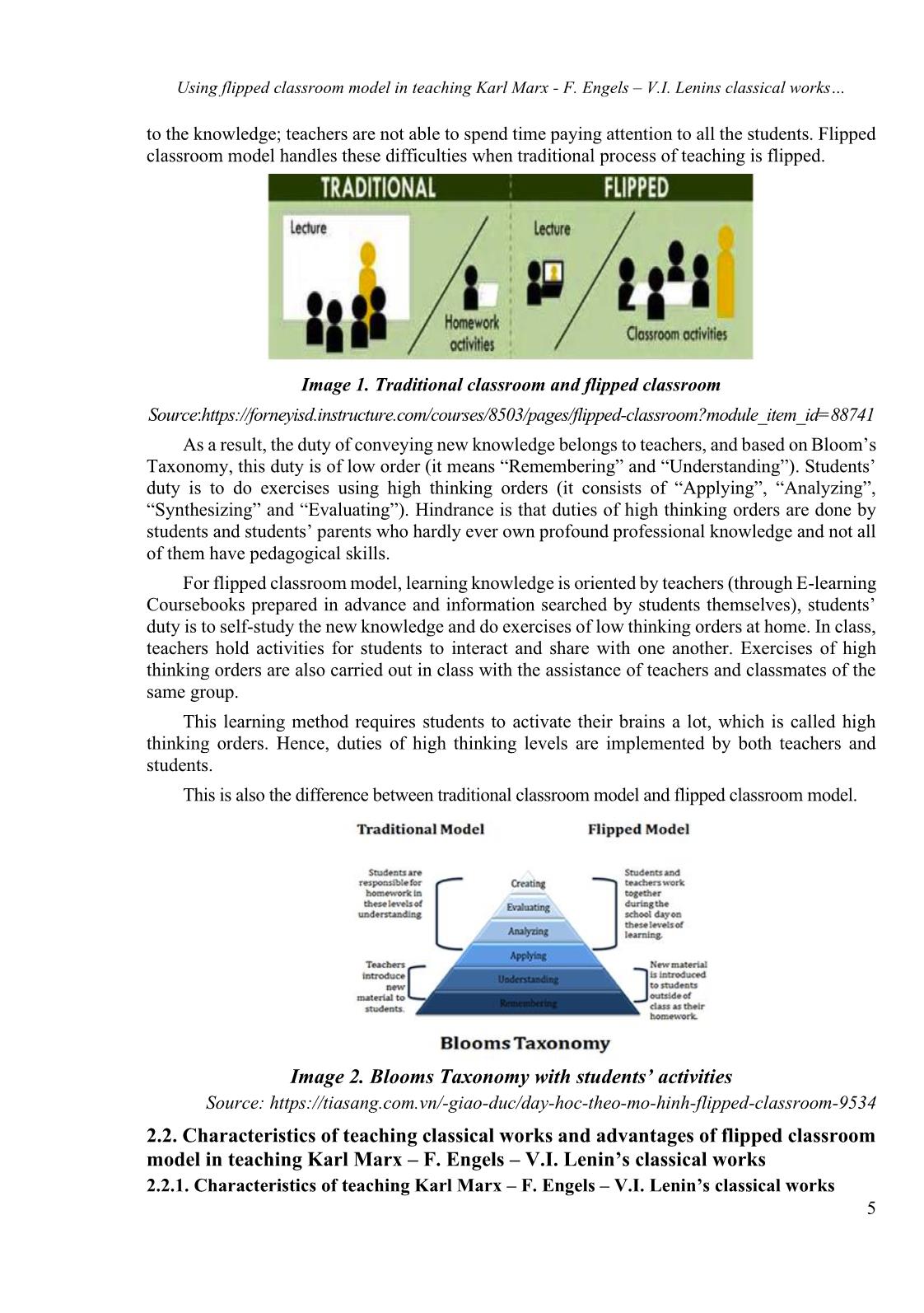
Trang 3
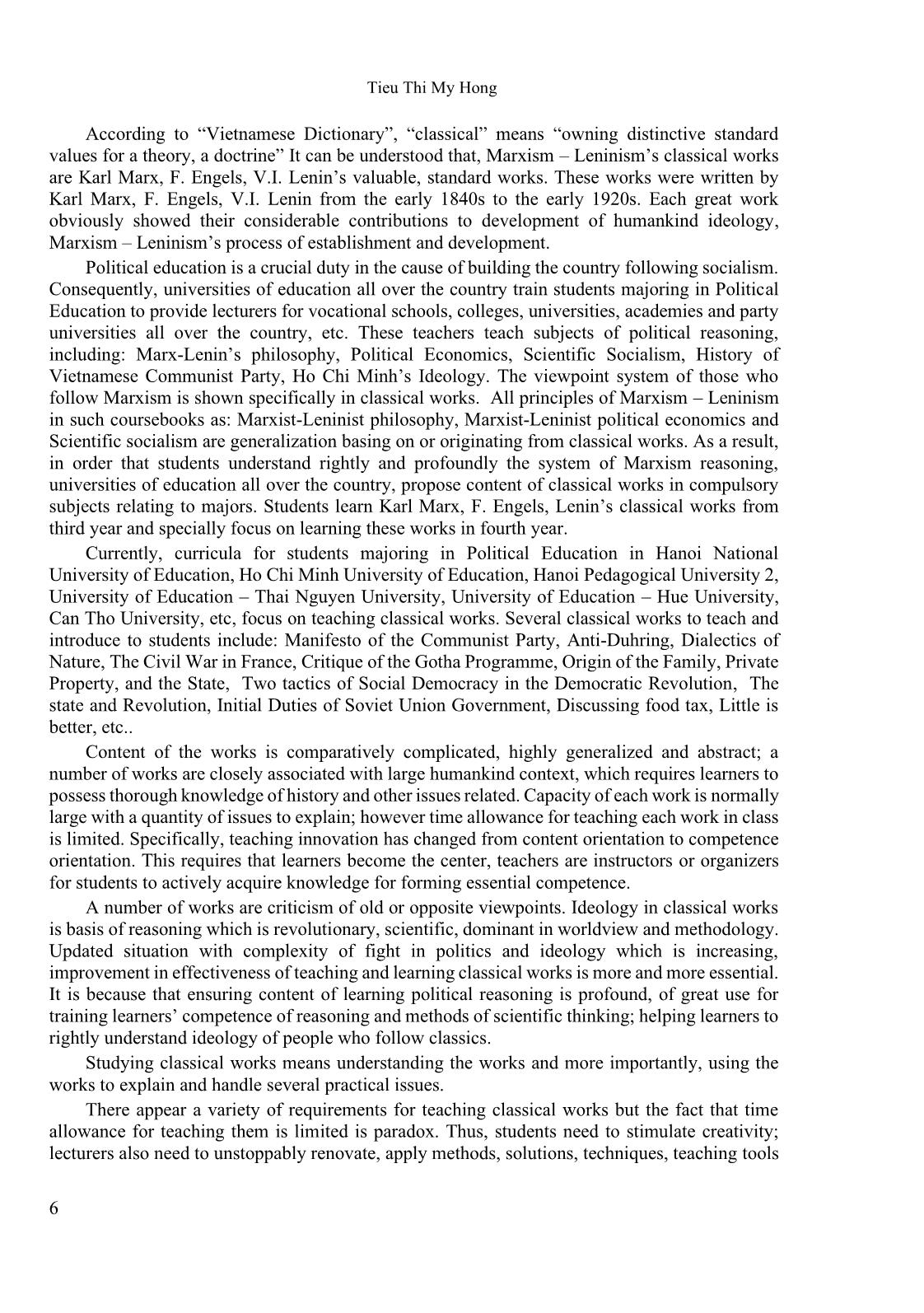
Trang 4
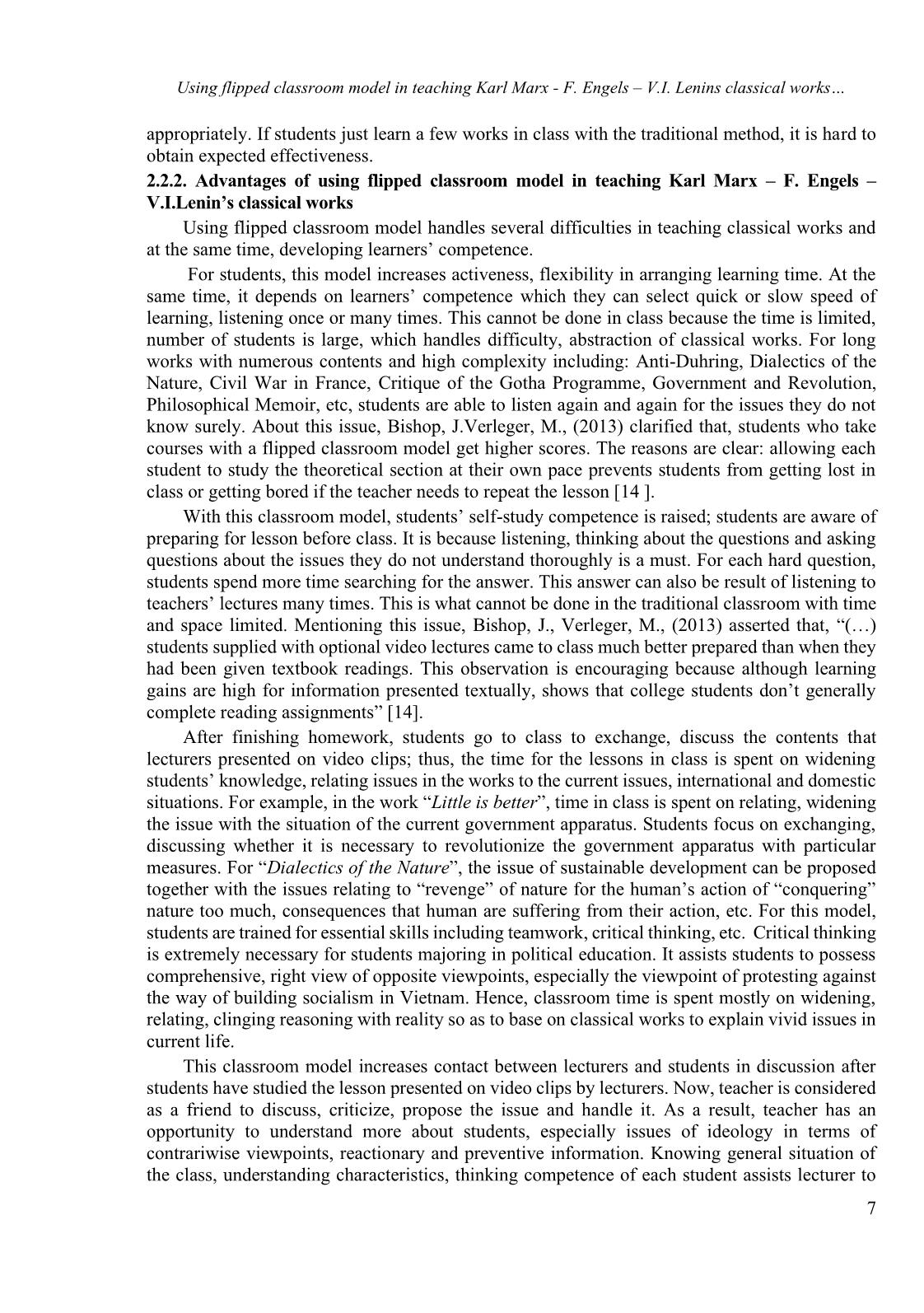
Trang 5
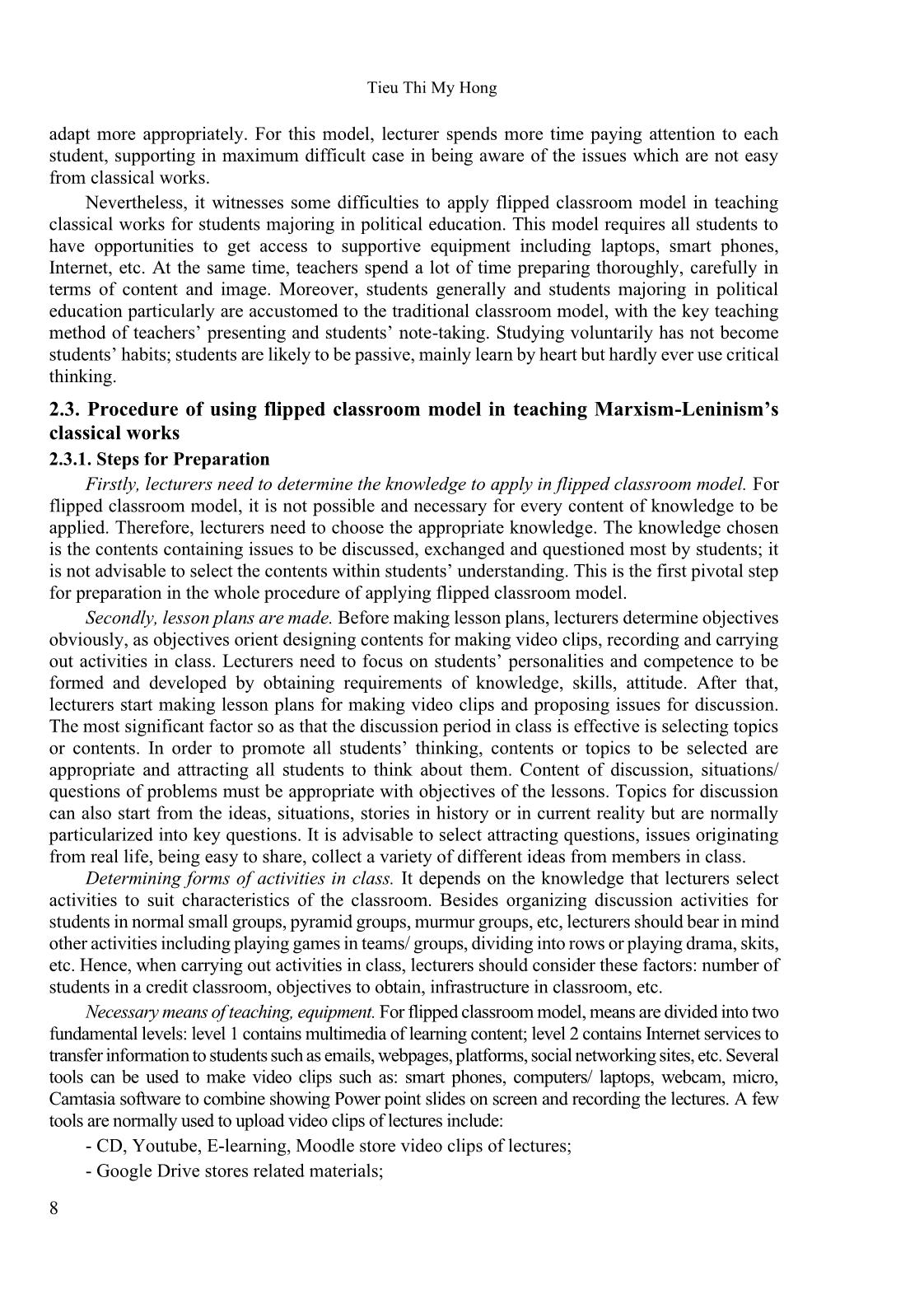
Trang 6
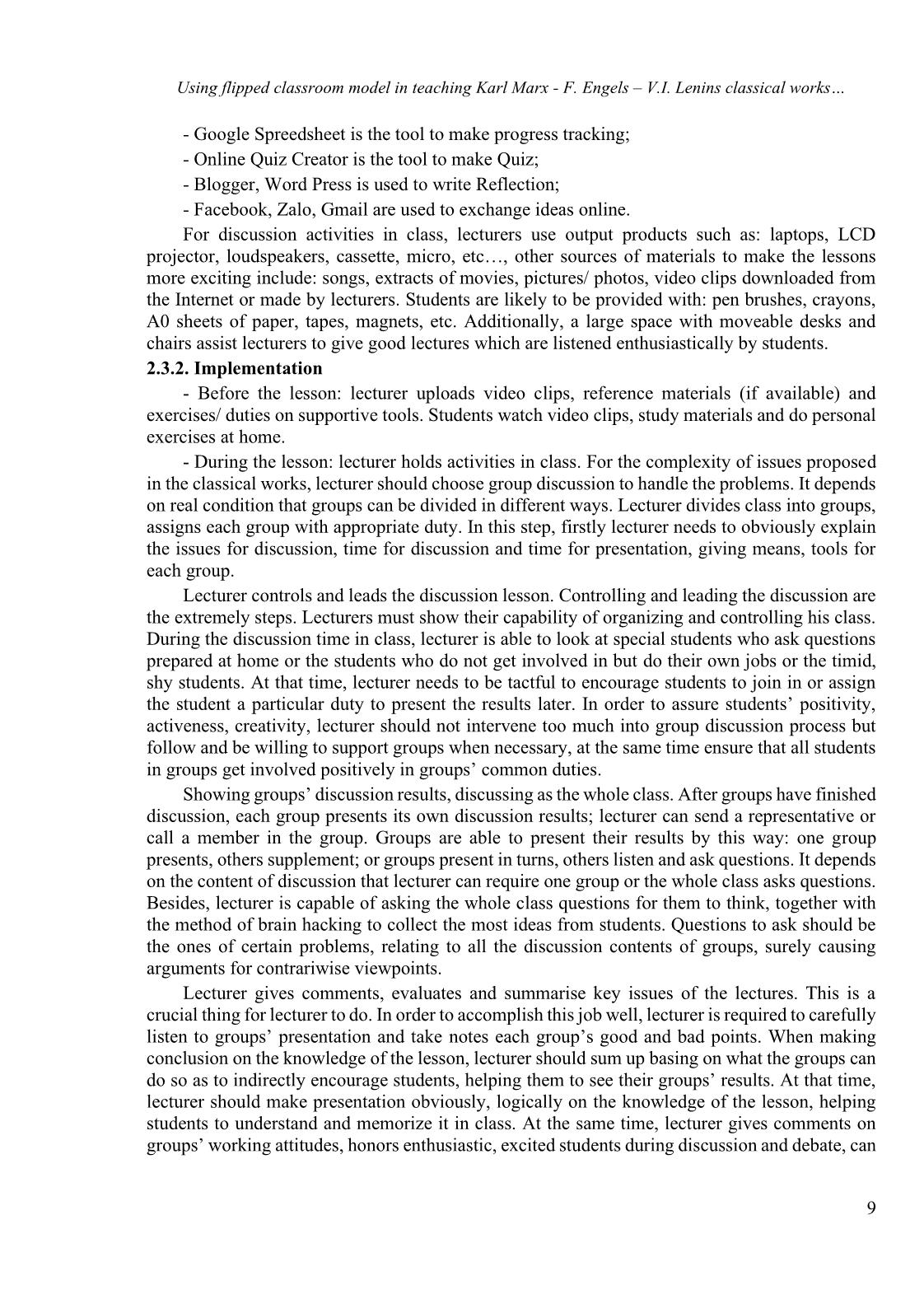
Trang 7
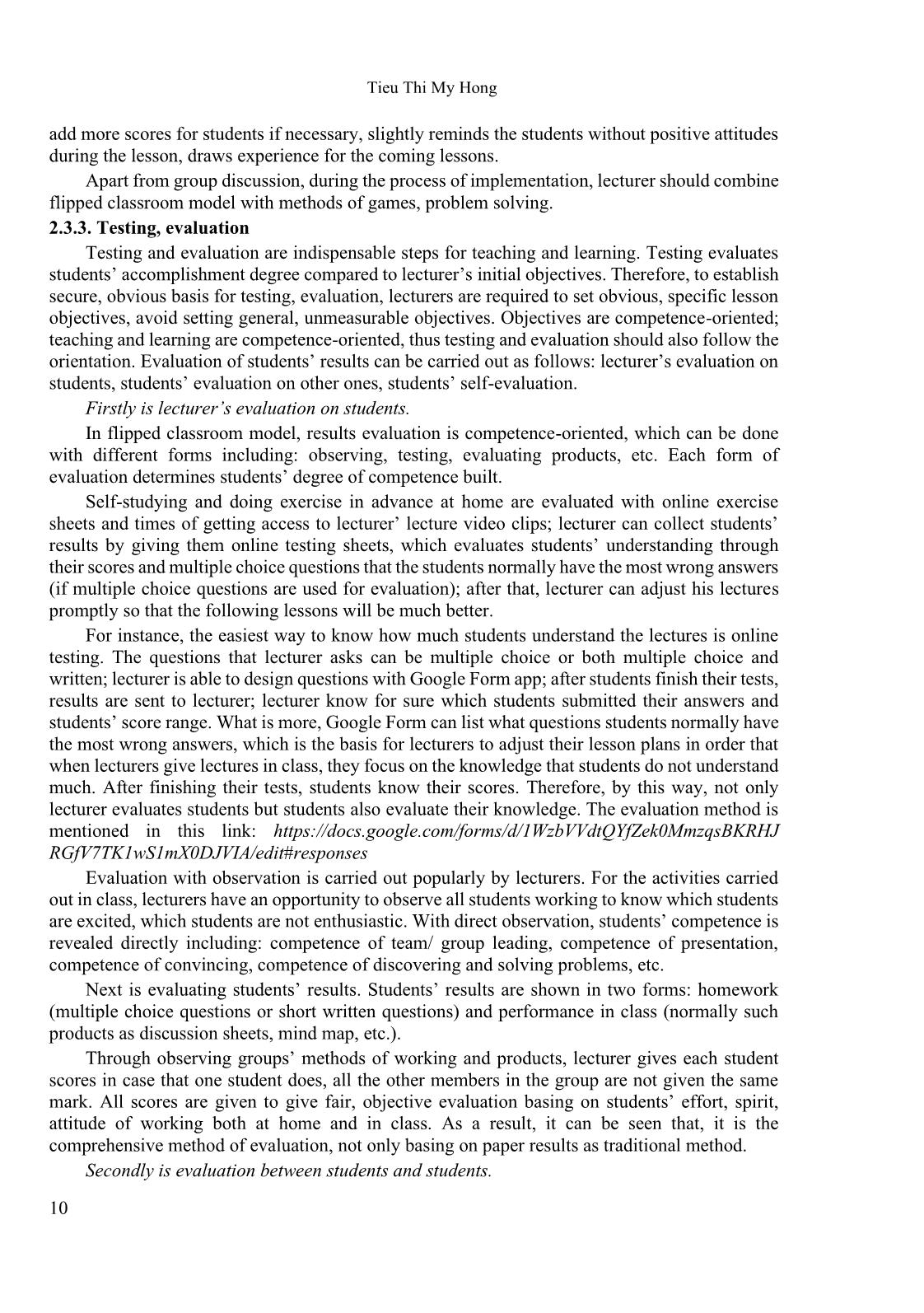
Trang 8
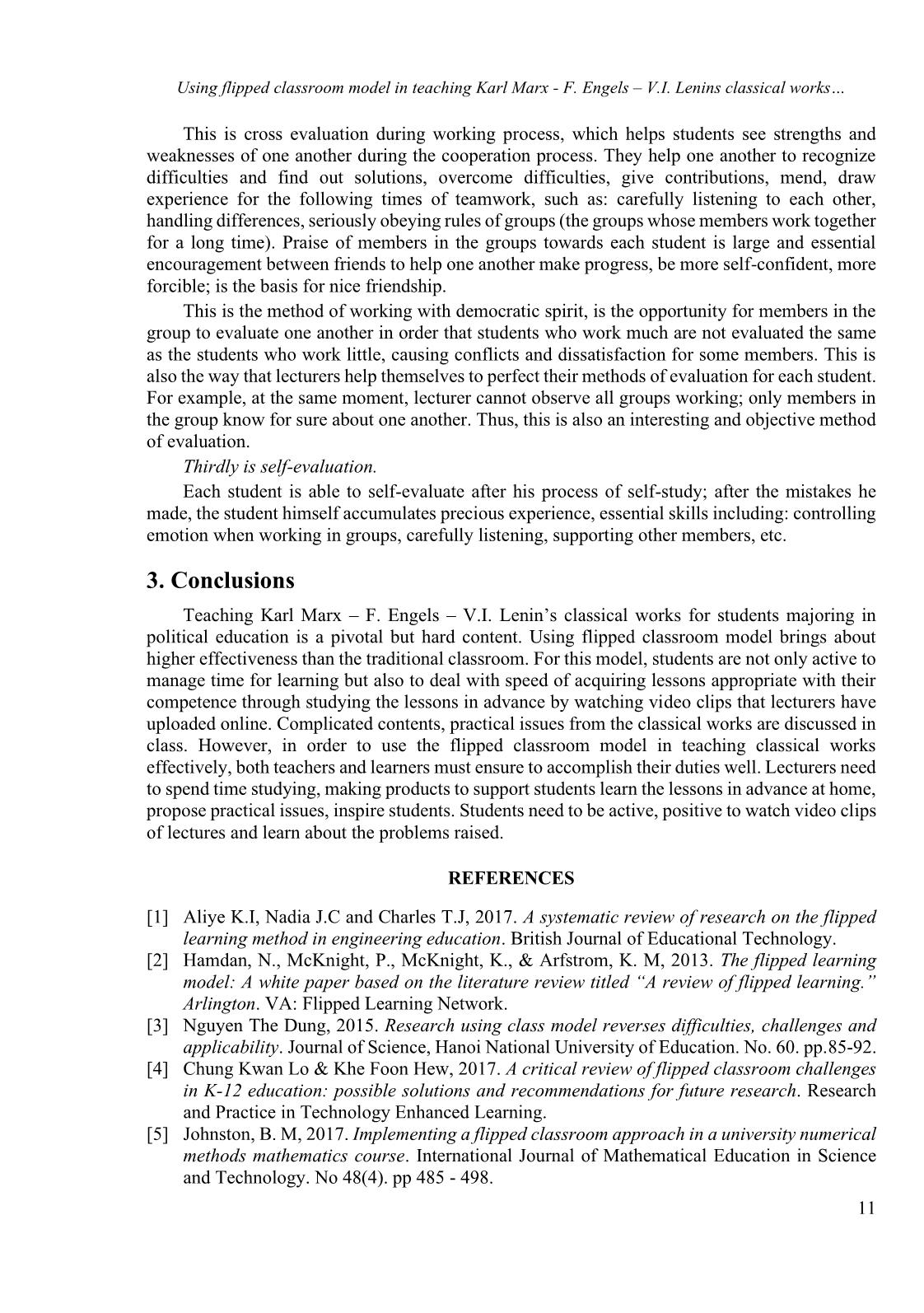
Trang 9
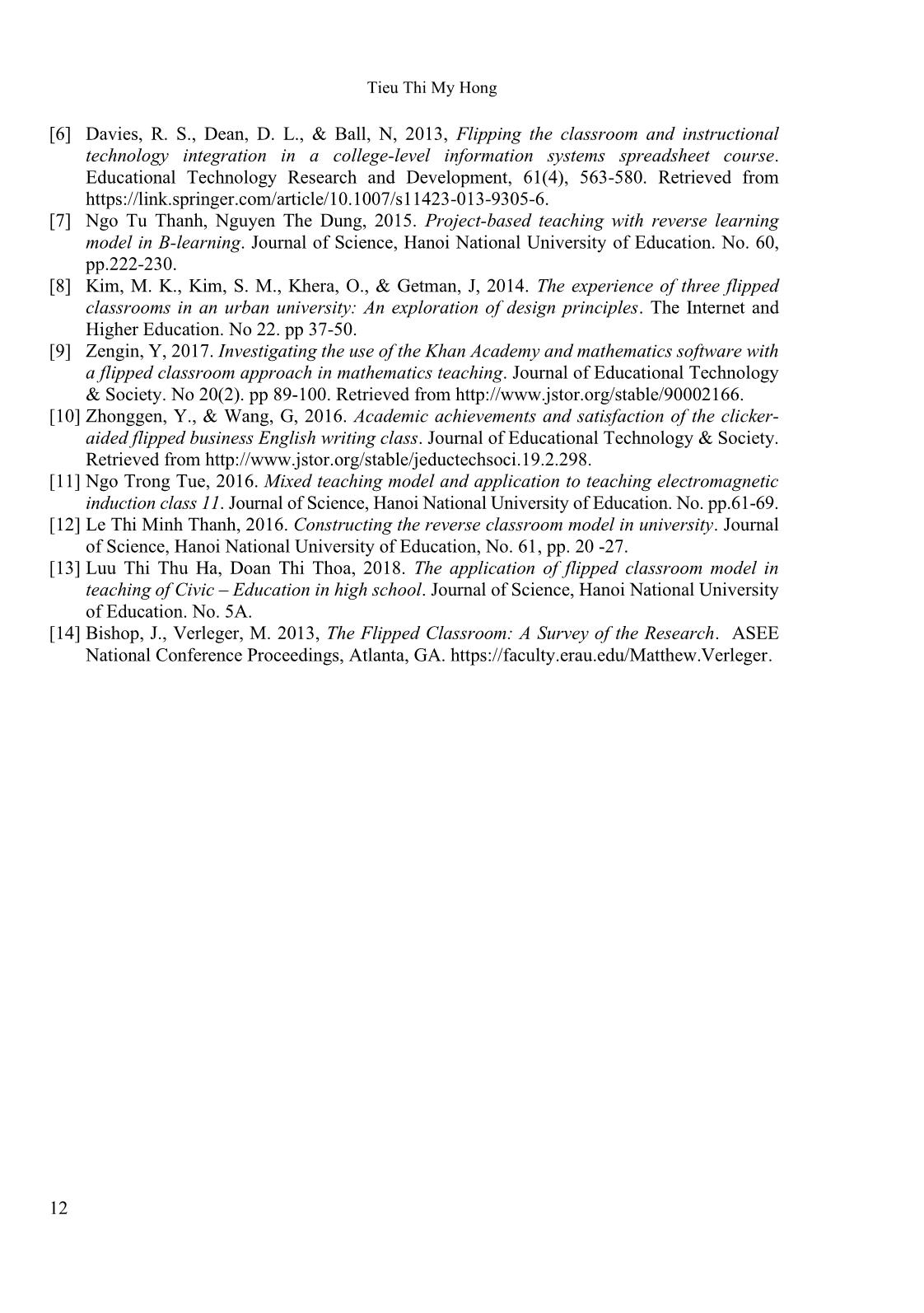
Trang 10
Tóm tắt nội dung tài liệu: Using flipped classroom model in teaching karl Marx - F. Engels – V.I. Lenin’s classical works for students majoring in political education
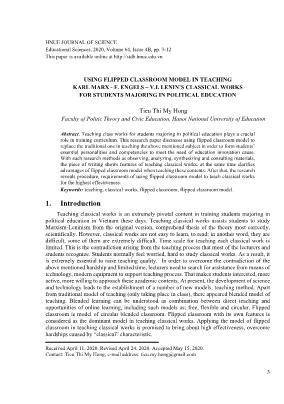
into rows or playing drama, skits, etc. Hence, when carrying out activities in class, lecturers should consider these factors: number of students in a credit classroom, objectives to obtain, infrastructure in classroom, etc. Necessary means of teaching, equipment. For flipped classroom model, means are divided into two fundamental levels: level 1 contains multimedia of learning content; level 2 contains Internet services to transfer information to students such as emails, webpages, platforms, social networking sites, etc. Several tools can be used to make video clips such as: smart phones, computers/ laptops, webcam, micro, Camtasia software to combine showing Power point slides on screen and recording the lectures. A few tools are normally used to upload video clips of lectures include: - CD, Youtube, E-learning, Moodle store video clips of lectures; - Google Drive stores related materials; Using flipped classroom model in teaching Karl Marx - F. Engels – V.I. Lenins classical works 9 - Google Spreedsheet is the tool to make progress tracking; - Online Quiz Creator is the tool to make Quiz; - Blogger, Word Press is used to write Reflection; - Facebook, Zalo, Gmail are used to exchange ideas online. For discussion activities in class, lecturers use output products such as: laptops, LCD projector, loudspeakers, cassette, micro, etc, other sources of materials to make the lessons more exciting include: songs, extracts of movies, pictures/ photos, video clips downloaded from the Internet or made by lecturers. Students are likely to be provided with: pen brushes, crayons, A0 sheets of paper, tapes, magnets, etc. Additionally, a large space with moveable desks and chairs assist lecturers to give good lectures which are listened enthusiastically by students. 2.3.2. Implementation - Before the lesson: lecturer uploads video clips, reference materials (if available) and exercises/ duties on supportive tools. Students watch video clips, study materials and do personal exercises at home. - During the lesson: lecturer holds activities in class. For the complexity of issues proposed in the classical works, lecturer should choose group discussion to handle the problems. It depends on real condition that groups can be divided in different ways. Lecturer divides class into groups, assigns each group with appropriate duty. In this step, firstly lecturer needs to obviously explain the issues for discussion, time for discussion and time for presentation, giving means, tools for each group. Lecturer controls and leads the discussion lesson. Controlling and leading the discussion are the extremely steps. Lecturers must show their capability of organizing and controlling his class. During the discussion time in class, lecturer is able to look at special students who ask questions prepared at home or the students who do not get involved in but do their own jobs or the timid, shy students. At that time, lecturer needs to be tactful to encourage students to join in or assign the student a particular duty to present the results later. In order to assure students’ positivity, activeness, creativity, lecturer should not intervene too much into group discussion process but follow and be willing to support groups when necessary, at the same time ensure that all students in groups get involved positively in groups’ common duties. Showing groups’ discussion results, discussing as the whole class. After groups have finished discussion, each group presents its own discussion results; lecturer can send a representative or call a member in the group. Groups are able to present their results by this way: one group presents, others supplement; or groups present in turns, others listen and ask questions. It depends on the content of discussion that lecturer can require one group or the whole class asks questions. Besides, lecturer is capable of asking the whole class questions for them to think, together with the method of brain hacking to collect the most ideas from students. Questions to ask should be the ones of certain problems, relating to all the discussion contents of groups, surely causing arguments for contrariwise viewpoints. Lecturer gives comments, evaluates and summarise key issues of the lectures. This is a crucial thing for lecturer to do. In order to accomplish this job well, lecturer is required to carefully listen to groups’ presentation and take notes each group’s good and bad points. When making conclusion on the knowledge of the lesson, lecturer should sum up basing on what the groups can do so as to indirectly encourage students, helping them to see their groups’ results. At that time, lecturer should make presentation obviously, logically on the knowledge of the lesson, helping students to understand and memorize it in class. At the same time, lecturer gives comments on groups’ working attitudes, honors enthusiastic, excited students during discussion and debate, can Tieu Thi My Hong 10 add more scores for students if necessary, slightly reminds the students without positive attitudes during the lesson, draws experience for the coming lessons. Apart from group discussion, during the process of implementation, lecturer should combine flipped classroom model with methods of games, problem solving. 2.3.3. Testing, evaluation Testing and evaluation are indispensable steps for teaching and learning. Testing evaluates students’ accomplishment degree compared to lecturer’s initial objectives. Therefore, to establish secure, obvious basis for testing, evaluation, lecturers are required to set obvious, specific lesson objectives, avoid setting general, unmeasurable objectives. Objectives are competence-oriented; teaching and learning are competence-oriented, thus testing and evaluation should also follow the orientation. Evaluation of students’ results can be carried out as follows: lecturer’s evaluation on students, students’ evaluation on other ones, students’ self-evaluation. Firstly is lecturer’s evaluation on students. In flipped classroom model, results evaluation is competence-oriented, which can be done with different forms including: observing, testing, evaluating products, etc. Each form of evaluation determines students’ degree of competence built. Self-studying and doing exercise in advance at home are evaluated with online exercise sheets and times of getting access to lecturer’ lecture video clips; lecturer can collect students’ results by giving them online testing sheets, which evaluates students’ understanding through their scores and multiple choice questions that the students normally have the most wrong answers (if multiple choice questions are used for evaluation); after that, lecturer can adjust his lectures promptly so that the following lessons will be much better. For instance, the easiest way to know how much students understand the lectures is online testing. The questions that lecturer asks can be multiple choice or both multiple choice and written; lecturer is able to design questions with Google Form app; after students finish their tests, results are sent to lecturer; lecturer know for sure which students submitted their answers and students’ score range. What is more, Google Form can list what questions students normally have the most wrong answers, which is the basis for lecturers to adjust their lesson plans in order that when lecturers give lectures in class, they focus on the knowledge that students do not understand much. After finishing their tests, students know their scores. Therefore, by this way, not only lecturer evaluates students but students also evaluate their knowledge. The evaluation method is mentioned in this link: https://docs.google.com/forms/d/1WzbVVdtQYfZek0MmzqsBKRHJ RGfV7TK1wS1mX0DJVIA/edit#responses Evaluation with observation is carried out popularly by lecturers. For the activities carried out in class, lecturers have an opportunity to observe all students working to know which students are excited, which students are not enthusiastic. With direct observation, students’ competence is revealed directly including: competence of team/ group leading, competence of presentation, competence of convincing, competence of discovering and solving problems, etc. Next is evaluating students’ results. Students’ results are shown in two forms: homework (multiple choice questions or short written questions) and performance in class (normally such products as discussion sheets, mind map, etc.). Through observing groups’ methods of working and products, lecturer gives each student scores in case that one student does, all the other members in the group are not given the same mark. All scores are given to give fair, objective evaluation basing on students’ effort, spirit, attitude of working both at home and in class. As a result, it can be seen that, it is the comprehensive method of evaluation, not only basing on paper results as traditional method. Secondly is evaluation between students and students. Using flipped classroom model in teaching Karl Marx - F. Engels – V.I. Lenins classical works 11 This is cross evaluation during working process, which helps students see strengths and weaknesses of one another during the cooperation process. They help one another to recognize difficulties and find out solutions, overcome difficulties, give contributions, mend, draw experience for the following times of teamwork, such as: carefully listening to each other, handling differences, seriously obeying rules of groups (the groups whose members work together for a long time). Praise of members in the groups towards each student is large and essential encouragement between friends to help one another make progress, be more self-confident, more forcible; is the basis for nice friendship. This is the method of working with democratic spirit, is the opportunity for members in the group to evaluate one another in order that students who work much are not evaluated the same as the students who work little, causing conflicts and dissatisfaction for some members. This is also the way that lecturers help themselves to perfect their methods of evaluation for each student. For example, at the same moment, lecturer cannot observe all groups working; only members in the group know for sure about one another. Thus, this is also an interesting and objective method of evaluation. Thirdly is self-evaluation. Each student is able to self-evaluate after his process of self-study; after the mistakes he made, the student himself accumulates precious experience, essential skills including: controlling emotion when working in groups, carefully listening, supporting other members, etc. 3. Conclusions Teaching Karl Marx – F. Engels – V.I. Lenin’s classical works for students majoring in political education is a pivotal but hard content. Using flipped classroom model brings about higher effectiveness than the traditional classroom. For this model, students are not only active to manage time for learning but also to deal with speed of acquiring lessons appropriate with their competence through studying the lessons in advance by watching video clips that lecturers have uploaded online. Complicated contents, practical issues from the classical works are discussed in class. However, in order to use the flipped classroom model in teaching classical works effectively, both teachers and learners must ensure to accomplish their duties well. Lecturers need to spend time studying, making products to support students learn the lessons in advance at home, propose practical issues, inspire students. Students need to be active, positive to watch video clips of lectures and learn about the problems raised. REFERENCES [1] Aliye K.I, Nadia J.C and Charles T.J, 2017. A systematic review of research on the flipped learning method in engineering education. British Journal of Educational Technology. [2] Hamdan, N., McKnight, P., McKnight, K., & Arfstrom, K. M, 2013. The flipped learning model: A white paper based on the literature review titled “A review of flipped learning.” Arlington. VA: Flipped Learning Network. [3] Nguyen The Dung, 2015. Research using class model reverses difficulties, challenges and applicability. Journal of Science, Hanoi National University of Education. No. 60. pp.85-92. [4] Chung Kwan Lo & Khe Foon Hew, 2017. A critical review of flipped classroom challenges in K-12 education: possible solutions and recommendations for future research. Research and Practice in Technology Enhanced Learning. [5] Johnston, B. M, 2017. Implementing a flipped classroom approach in a university numerical methods mathematics course. International Journal of Mathematical Education in Science and Technology. No 48(4). pp 485 - 498. Tieu Thi My Hong 12 [6] Davies, R. S., Dean, D. L., & Ball, N, 2013, Flipping the classroom and instructional technology integration in a college-level information systems spreadsheet course. Educational Technology Research and Development, 61(4), 563-580. Retrieved from https://link.springer.com/article/10.1007/s11423-013-9305-6. [7] Ngo Tu Thanh, Nguyen The Dung, 2015. Project-based teaching with reverse learning model in B-learning. Journal of Science, Hanoi National University of Education. No. 60, pp.222-230. [8] Kim, M. K., Kim, S. M., Khera, O., & Getman, J, 2014. The experience of three flipped classrooms in an urban university: An exploration of design principles. The Internet and Higher Education. No 22. pp 37-50. [9] Zengin, Y, 2017. Investigating the use of the Khan Academy and mathematics software with a flipped classroom approach in mathematics teaching. Journal of Educational Technology & Society. No 20(2). pp 89-100. Retrieved from [10] Zhonggen, Y., & Wang, G, 2016. Academic achievements and satisfaction of the clicker- aided flipped business English writing class. Journal of Educational Technology & Society. Retrieved from [11] Ngo Trong Tue, 2016. Mixed teaching model and application to teaching electromagnetic induction class 11. Journal of Science, Hanoi National University of Education. No. pp.61-69. [12] Le Thi Minh Thanh, 2016. Constructing the reverse classroom model in university. Journal of Science, Hanoi National University of Education, No. 61, pp. 20 -27. [13] Luu Thi Thu Ha, Doan Thi Thoa, 2018. The application of flipped classroom model in teaching of Civic – Education in high school. Journal of Science, Hanoi National University of Education. No. 5A. [14] Bishop, J., Verleger, M. 2013, The Flipped Classroom: A Survey of the Research. ASEE National Conference Proceedings, Atlanta, GA. https://faculty.erau.edu/Matthew.Verleger.
File đính kèm:
 using_flipped_classroom_model_in_teaching_karl_marx_f_engels.pdf
using_flipped_classroom_model_in_teaching_karl_marx_f_engels.pdf

